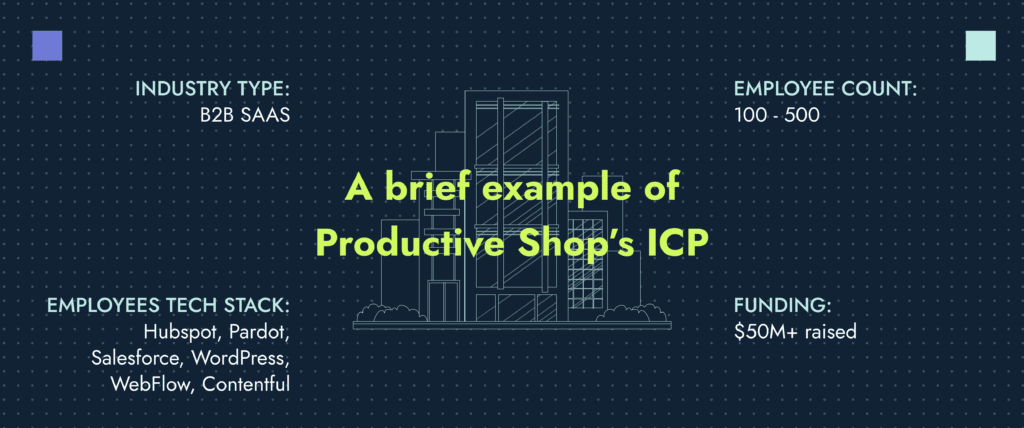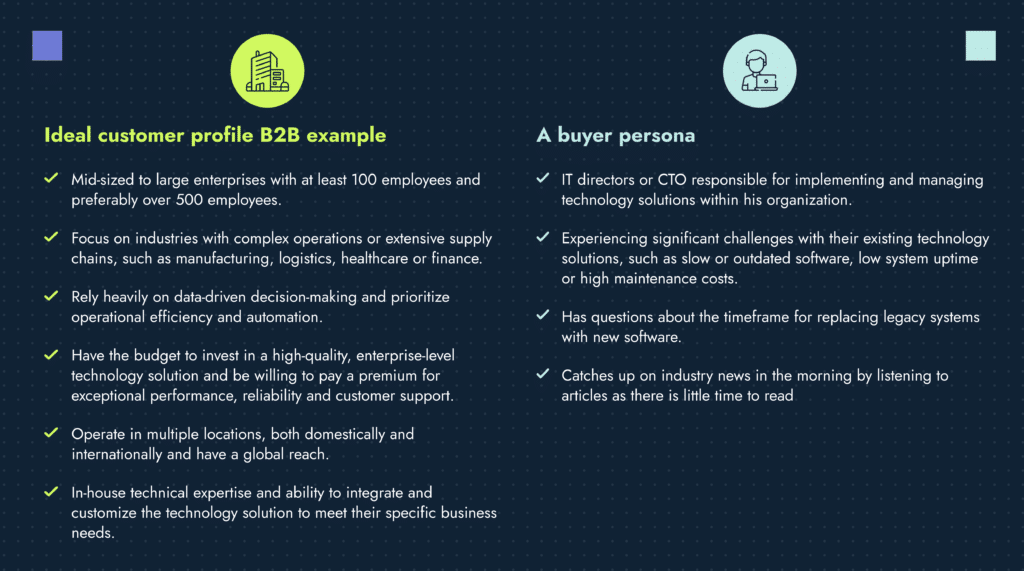Are your sales reps spending lots of time on B2B leads that aren’t a good fit for your business? An ideal customer profile (ICP) is an integral part of the sales strategy that can help you solve this problem.
An ICP is a crucial strategic document that guides business downstream efforts. As a CMO, developing an effective ICP involves close collaboration with key stakeholders, careful data analysis and validation of defined profiles.
What is an ideal customer profile?
Also known as an ideal buyer profile, an ideal customer profile is a hypothetical description of the type of person who is most likely to benefit from your product or service and become a loyal and profitable customer.

If your organization leverages account-based marketing (ABM), an ICP empowers you to focus your sales efforts on targeted accounts that fit your company’s offers. With an ICP, you can identify your target audience’s key characteristics, needs, behaviors and preferences to help you create targeted marketing campaigns and sales strategies that resonate with them.
What should an ICP contain?
An ICP should have both firmographic and technographic data to help CMOs and sales teams understand who the qualified leads are.
Firmographic data
This data type enables you to build a well-defined profile as it helps you understand the business background of your B2B prospects. By reviewing your products and services against leads’ pain points, firmographic data helps you segment your potential customers.
These characteristics fall under firmographics:
- Revenue size. The average contract value or lowest cost threshold for a customer to work with you and the optimal amount that makes the business relationship favorable to both parties.
- Product type. The nature of industries or range of products that a customer should be selling to make a great fit for your organization.
- Employee count. The number of employees your ideal clients should have. For example, no fewer than 100 verified LinkedIn employees.
- Organizational structure. Specific teams or internal departments such as in-house customer success or presales teams.
- Location. The general region in which headquarters are located and possible subsidiaries.
Technographic data
This type of data highlights how your ideal prospect uses technology. As a B2B SaaS company, you can gain insight into a company’s tech stack and its reasons for purchasing certain technological solutions.
Technographic data spans these four parameters:
- Existing tech solutions. What is included in your technology stack?
-
- Martech tools. Software and technology platforms used by marketers to automate, optimize and analyze their marketing campaigns. These tools include marketing automation and customer relationship management (CRM) software and analytics platforms. Examples are HubSpot and Salesforce.
- Sales intelligence solutions. Tools that help sales teams identify and prioritize leads through features such as lead scoring, predictive analytics and data visualization. Examples include LinkedIn Sales Navigator and ZoomInfo Sales OS.
- Storage servers and mail services. Technologies critical for communication and collaboration within the business and for external communication with customers, partners and other stakeholders. Tools such as Google Workspace and Slack fall under this category.
-
- Number of solutions in the product suite. How many different offerings are available?
- Percentage of technology used. How much of each solution in a tech stack is actively used?
- Adoption time for the latest technology. How long does upgrading from legacy technology to new innovative solutions take?
The contents of an ICP are often confused with a buyer persona. I’ll explain what the latter is and distinguish between both resources, letting you know if you need one or the other in your organization.
→ Download now: ICP template for B2B marketing teams
What is a buyer persona?
A buyer persona outlines your ideal customer’s motivations, fears, information sources, as well as their demographic and geographic factors. Personalized marketing and sales strategies resulting from creating a buyer persona enables teams to experience a higher return on investment (ROI) and engagement.
Typical questions to consider in creating a buyer persona:
- Who is the specific team member who manages the areas we’re concerned about?
- What are their responsibilities?
- Who do they report to?
- What are their top frustrations and challenges?
- What KPIs are most important to them?
- What role do they play in the buying process?
Ideal customer profile vs buyer persona: Do you need both?
While ICPs and buyer personas are similar in that they both provide guidelines for your sales teams to qualify leads, there’s a difference in how and when to use them.
Here’s how to differentiate an ICP from a buyer persona:
| Ideal customer profile | Buyer persona |
|---|---|
| Created at the initial stage of a business or upon a significant change in the company's direction. | An offshoot of the ICP, it can be updated frequently as multiple products or features are deployed. |
| Gives a high-level overview of accounts (companies) your sales teams should target. | Is more specific as it doubles down on individuals within those companies. |
| Highlights characteristics of the company and its tech stack. | Highlights pain points of teams within these companies. |

🖋️ Key point: An ICP and a buyer persona are important resources for your marketing and sales efforts. Take the time to define both and remember to update them as your organization grows.
Benefits of an ideal customer profile
Since an ICP helps you define your target audience, you can accurately segment your customers, especially if you have multiple product offerings and the buyer journey.
Here’s why an ICP is important:
- Targeted marketing. By identifying your ideal customer, you can create targeted marketing campaigns that are more likely to resonate with them. This approach allows you to focus your marketing efforts on the customers who are most likely to buy from you, improving the effectiveness of your campaigns and reducing wasted marketing spend.
A good example of targeted marketing is the use of personalized emails based on segments created in your email service provider. HubSpot’s ultimate list of marketing statistics in 2022 reveals that personalized emails can improve click-through rates by 14%, increase conversions by 10% and generate 18 times more traffic than usual. With an ICP, you can create the right segments and put the right prospects within them. - Sales strategies. Understanding your ideal customer’s needs and preferences can help you tailor your sales strategies to appeal to them. With custom sales strategies, which inform how your sales team positions products to customers, you close more deals, improve your conversion rates and create a more fluid sales process. This approach increases your organization’s revenue and keeps your sales pipeline filled.
- Product development. Knowing your ideal customer can help you develop products and services that are better suited to their needs and preferences. An ICP helps your team lay out a future product roadmap with updates and changes. This capability can help you improve customer satisfaction, build loyalty and increase customer lifetime value (CLV).
For example, if your ICP revolves around SaaS startups, you can create plans to expand your product offerings, which allows you to scale with your existing customers when they grow and still cater to upcoming startups. - Customer retention. Per Gartner, only about 15% of client interactions provide value enhancement, which involves increasing the relative value and profitability of an organization while mitigating risks. By understanding your ideal customer, you can provide value in every interaction and create better customer experiences that are more likely to lead to repeat business and customer loyalty.
Measuring the accuracy of your ICP in business
Creating an ICP does not guarantee that you’ve accurately identified your ideal client unless you validate your findings.
As a CMO, you need to track marketing and sales KPIs, presales and closed-won metrics to verify that your ICP is on track. These metrics indicate whether or not you’re targeting the right leads and whether your message is resonating with prospects.
Here are KPIs to measure the accuracy of your ICP:
- Marketing qualified lead (MQL). By measuring the number of qualified leads from your email marketing, paid advertising and organic lead gen efforts such as search engine optimization (SEO), you can verify that your ICP is accurate
- Conversion rates. One of the most important KPIs to track is the conversion rate, which measures the percentage of leads that take intended actions. These KPIs can range from demos booked to sales. If your ICP is accurate, you should see a higher conversion rate from the leads that match your B2B ideal customer profile.
- Cold outreach responses. By tracking the replies from leads that match your ICP, you can verify the accuracy of your profile. If you receive positive responses from cold pitches, then your ICP is on target.
- Bounce rates. If prospects from your paid and organic efforts — based on insights from your ICP — spend a healthy amount of time on your site with a low bounce rate, you’re on the right track.
- Customer acquisition cost (CAC). This KPI measures the total cost incurred to acquire a new customer. By tracking CAC, you can determine if your marketing and sales efforts target the right audience. With an accurate ICP, you should see a lower CAC as you target the customers most likely to convert.
- Customer lifetime value (CLV). You can track the total value a customer will bring to your business over their lifetime. With the right ICP, you should see a higher CLV as you attract customers who are a good fit for your business and are likely to stay with you for a longer period.
- Customer feedback. You can also gather feedback from your existing customers to validate your ICP. If your ICP is accurate, your existing customers should match the characteristics and behaviors identified in your profile.
How to create an ideal customer profile?
Your ICP is essential in creating a go-to-market (GTM) strategy and a helpful tool for driving product led growth.
Follow these five steps to define your ideal customer profile in B2B:
1. Gather customer data
Make a list of about ten of your best customers and collect data, such as demographics, industry, interests, purchasing habits and pain points. Your team can conduct this research through surveys, interviews, social media monitoring and website analytics.
In determining your best customers, consider these two questions:
- How much is the customer paying you?
- How much value is the customer getting from your solution?
💡 Have trouble identifying at least seven of your best customers due to a lack of ideal prospects? See how we can help you enhance your demand generation.
2. Analyze the data
Once you have gathered the data, analyze it to identify patterns and trends from each customer. Look for commonalities among your best customers, such as demographics, behaviors and preferences.
Consider these questions in developing an extensive list of patterns with your best customers:
- Is there a given role or department in their organization that helps them maximize or get more value from your solution?
- What’s the average number of employees at their company?
- Are organizations with more employees choosing certain products?
- Are there similarities in their geographical location?
- Are there specific industries your best clients come from?
- What kind of technology do they adopt?
Knowing as many similar characteristics as possible will help you in developing a realistic profile.
3. Identify pain points
Understand your customers’ pain points and challenges. What motivates them to buy your product or service? What challenges do they face that your product can solve? Identifying qualitative and quantitative data from pain points can help you derive a new upmarket ICP.
CMOs should visit sites such as Gartner reviews, G2, Software Advice, Trustpilot, Quora and Reddit to discover clients’ pain points. Also, this is a great opportunity to find out what your competitors’ customers say about features, services and overall dashboards.
4. Develop customer personas
Use the data and insights you have gathered to develop customer personas, which are fictional representations of your ideal customers. Aim between five and ten core attributes in defining your ICP. Give each persona a name, job title and a detailed description of their needs, preferences and behaviors.
5. Refine the personas
An ICP is only useful if it provides you with clarity. Continuously refine your ICP with relevant attributes and update your customer personas at least twice a year as you gather more data. Updating the ICP is crucial as customer behavior and preferences change over time. Monitor customer feedback, social media interactions and website analytics to align your marketing sales and demand gen efforts with customer needs.
👉 Still unsure of how to build an ICP that accurately represents your most promising prospects? You can use our ideal customer profile template as your guide.
Activating your ICP in marketing and sales funnels
By activating your ICP, you can synchronize your ideal customer profile across your go-to-market tools and channels, enabling you to effectively acquire your best-fit customers in a scalable and cost-effective manner.
These are some ways you can activate your ICP throughout your B2B sales funnel:
- Lead scoring. Assign the highest score and route accounts that match your ICP to the appropriate individuals, ensuring prompt follow-up. For example, your scoring system can involve assigning a point for each action a prospect takes in your sales funnel — for example, accessing your website, making an inquiry and downloading a lead magnet. If an account still doesn’t meet your ICP, consider adding additional steps to the qualification process to ensure it aligns with your criteria before passing it to sales.
- Ad targeting. Choose the appropriate ad platforms where your target audience spends the most time. For example, an organization targeting B2B SaaS companies may find the most success with Google and Twitter ads since these are social platforms where many professionals spend their time. Effective targeting, messaging and channel selection can help you create impactful ad experiences that lead to conversions.
- Web personalization. The biggest challenge that ABM teams face is personalizing their web strategy, according to HubSpot. Personalizing web experiences can enable B2B teams to deliver tailored journeys that effectively guide buyers through the funnel. For example, you can help prospects auto-fill forms through contact data and tailor your website results such as pricing based on geolocation and profile characteristics.
- Intent-based prospecting. You can identify accounts that match your ICP and are browsing your website, allowing for more personalized outreach along the buyer journey. Leveraging intent data can enhance your approach to generating new business, upsells, renewals, re-engaging closed lost customers or identifying the size of a buying committee.
Practical ways of using an ideal customer profile framework
An ideal customer profile can guide business decisions and improve overall business performance.
Practical ways to leverage an ICP framework include:
- Finding prospects. Using your ICP, you can identify the characteristics that your most profitable customers share and use that information to target new prospects who match that profile. This strategy can help you focus your sales efforts on the most promising leads, increasing your chances of converting them into paying customers along the buyer journey.
- Adjusting your pricing. An ICP can also inform your pricing strategy by identifying the features and benefits that your ideal customers value most. By understanding what drives customer value, you can set prices that are aligned with their needs and preferences, leading to better pricing decisions.
- Forming partnerships. Collaborating with other companies that share a similar target audience but are not direct competitors can be an effective way to expand your reach and increase brand awareness. Using your ICP, you can identify potential partnership opportunities and develop mutually beneficial relationships with other businesses.
- Shaping your messaging across all platforms. Your ICP can inform your messaging strategy by identifying the language, tone and style that resonates with your ideal customers. Using this information, you can develop consistent messaging across all platforms, from your website and social media to your email campaigns and advertisements.
Download our ICP template for a winning B2B marketing strategy
Creating an ICP doesn’t have to be a challenging process. To save time, we’ve created a worksheet for you with prompts to help you arrive at an accurate ICP.
Ready to enhance your sales strategy? We can help. 👇
Download free: ICP worksheet
Frequently asked questions
Which internal team should keep the ICP updated?
The ideal customer profile (ICP) document should be updated by the marketing team or the team responsible for customer research and analysis. While updating your ICP, consult other teams, such as sales, customer service and product development, as they can provide valuable insights based on their direct interactions with customers.
What is an example of an ideal customer?
Here’s an example of an ideal customer for a B2B SaaS company that provides project management software:
- Company: A project management SaaS company
- Ideal customer: A mid-sized technology company with a distributed team of 50-100 employees, working on complex projects that involve cross-functional collaboration. The organization values transparency, efficiency and accountability in their project management process. They have tried other project management tools but have struggled to find one that meets their needs. They are willing to invest in a tool that integrates with their existing systems and provides advanced reporting and analytics capabilities.
This ideal customer profile provides a clear understanding of the target business that the project management SaaS company aims to serve. By defining its ideal customer, the company can tailor its marketing efforts, product features and pricing strategies to better appeal to this specific group of businesses.
In which tool should I keep my ICP documentation?
You can keep your ICP documentation in file management systems, customer relationship management (CRM) software or knowledge repositories, such as Google Docs, Confluence, Notion, HubSpot or Microsoft SharePoint.
While you should consider your organization’s needs and preferences in storing your ICP insights, it is vital that your documentation is easily accessible, regularly updated and shared with the relevant teams to inform their decision-making processes.
However, keeping your team updated and managing ICP documentation across different platforms can be a challenge. If you’re seeking a straightforward and organized approach, our ideal customer profile worksheet is the perfect tool for you.






